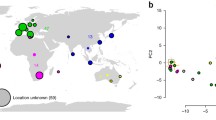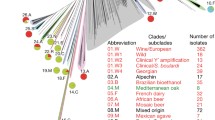Abstract
Over the last decade, mutation studies have grown in popularity due to the affordability and accessibility of whole genome sequencing. As the number of species in which spontaneous mutation has been directly estimated approaches 20 across two domains of life, questions arise over the repeatability of results in such experiments. Five species were identified in which duplicate mutation studies have been performed. Across these studies the difference in estimated spontaneous mutation rate is at most, weakly significant (p < 0.01). However, a highly significant (p < 10−5), threefold difference in the rate of insertions/deletions (indels) exists between two recent studies in Schizosaccharomyces pombe. Upon investigation of the ancestral genome sequence for both studies, a possible anti-mutator allele was identified. The observed variation in indel rate may imply that the use of indel markers, such as microsatellites, for the investigation of genetic diversity within and among populations may be inappropriate because of the assumption of uniform mutation rate within a species.


Similar content being viewed by others
References
Auwera GA, Carneiro MO, Hartl C, Poplin R, del Angel G, Levy-Moonshine A, Jordan T, Shakir K, Roazen D, Thibault J (2013). From FastQ data to high-confidence variant calls: the genome analysis toolkit best practices pipeline. Curr Protoc Bioinformatics, 11.10. 11–11.10. 33
Behringer MG, Hall DW (2016) Genome-wide estimates of mutation rates and spectrum in Schizosaccharomyces pombe indicate CpG sites are highly mutagenic despite the absence of DNA methylation. G3: Genes Genomes Genet 6(1):149–160
Chen K, Wallis JW, McLellan MD, Larson DE, Kalicki JM, Pohl CS, McGrath SD, Wendl MC, Zhang Q, Locke DP (2009) BreakDancer: an algorithm for high-resolution mapping of genomic structural variation. Nat Methods 6:677–681
Denver DR, Dolan PC, Wilhelm LJ, Sung W, Lucas-Lledó JI, Howe DK, Lewis SC, Okamoto K, Thomas WK, Lynch M (2009) A genome-wide view of Caenorhabditis elegans base-substitution mutation processes. Proc Natl Acad Sci 106:16310–16314
Denver DR, Wilhelm LJ, Howe DK, Gafner K, Dolan PC, Baer CF (2012) Variation in base-substitution mutation in experimental and natural lineages of Caenorhabditis nematodes. Genome Biol Evol 4(4):513–522
Dettman JR, Sztepanacz JL, Kassen R (2016) The properties of spontaneous mutations in the opportunistic pathogen Pseudomonas aeruginosa. BMC Genom 17:1
Dillon MM, Sung W, Lynch M, Cooper VS (2015) The rate and molecular spectrum of spontaneous mutations in the GC-rich multi-chromosome genome of Burkholderia cenocepacia. Genetics 115:176834
Drake JW (1991) A constant rate of spontaneous mutation in DNA-based microbes. Proc Natl Acad Sci 88:7160–7164
Farlow A, Long H, Arnoux S, Sung W, Doak TG, Nordborg M, Lynch M (2015) The spontaneous mutation rate in the fission yeast Schizosaccharomyces pombe. Genetics 201:737–744
Hu W, Suo F, Du L-L (2015) Bulk segregant analysis reveals the genetic basis of a natural trait variation in fission yeast. Genome Biol Evol 7:3496–3510
Jiang C, Mithani A, Belfield EJ, Mott R, Hurst LD, Harberd NP (2014) Environmentally responsive genome-wide accumulation of de novo Arabidopsis thaliana mutations and epimutations. Genome Res 24:1821–1829
Jiang Y, Turinsky AL, Brudno M (2015). The missing indels: an estimate of indel variation in a human genome and analysis of factors that impede detection. Nucleic acids research, gkv677
Keightley PD, Ness RW, Halligan DL, Haddrill PR (2014) Estimation of the spontaneous mutation rate per nucleotide site in a Drosophila melanogaster full-sib family. Genetics 196:313–320
Keightley PD, Pinharanda A, Ness RW, Simpson F, Dasmahapatra KK, Mallet J, Davey JW, Jiggins CD (2015) Estimation of the spontaneous mutation rate in Heliconius melpomene. Mol Biol Evol 32(1):239
Keith N, Tucker AE, Jackson CE, Sung W, Lledó JIL, Schrider DR, Schaack S, Dudycha JL, Ackerman MS, Younge AJ (2015) High mutational rates of large-scale duplication and deletion in Daphnia pulex. Genome Res 191338:191115
Kosarek JN, Woodruff RV, Rivera-Begeman A, Guo C, D’Souza S, Koonin EV, Walker GC, Friedberg EC (2008) Comparative analysis of in vivo interactions between Rev1 protein and other Y-family DNA polymerases in animals and yeasts. DNA Repair 7:439–451
Lee H, Popodi E, Tang H, Foster PL (2012) Rate and molecular spectrum of spontaneous mutations in the bacterium Escherichia coli as determined by whole-genome sequencing. Proc Natl Acad Sci 109:E2774–E2783
Li H, Durbin R (2009) Fast and accurate short read alignment with Burrows-Wheeler transform. Bioinformatics 25:1754–1760
Liu VF, Bhaumik D, Wang TS-F (1999) Mutator phenotype induced by aberrant replication. Mol Cell Biol 19:1126–1135
Long H, Kucukyildirim S, Sung W, Williams E, Lee H, Ackerman M, Doak TG, Tang H, Lynch M (2015). Background mutational features of the radiation-resistant bacterium Deinococcus radiodurans. Molecular biology and evolution, msv119
Long H, Sung W, Miller SF, Ackerman MS, Doak TG, Lynch M (2015b) Mutation rate, spectrum, topology, and context-dependency in the dna mismatch repair-deficient Pseudomonas fluorescens ATCC948. Gen Biol Evol 7:262–271
Long H, Winter DJ, Chang AYC, Sun W, Whu SH, Balboa M, Azevedo RB, Cartwright RA, Lynch M, Zufall RA (2015) Low base-substitution mutation rate in the ciliate Tetrahymena thermophila. bioRxiv:025536
Lynch M, Blanchard J, Houle D, Kibota T, Schultz S, Vassilieva L, Willis J (1999) Perspective: spontaneous deleterious mutation. Evolution 53:645–663
Lynch M, Sung W, Morris K, Coffey N, Landry CR, Dopman EB, Dickinson WJ, Okamoto K, Kulkarni S, Hartl DL (2008) A genome-wide view of the spectrum of spontaneous mutations in yeast. Proc Natl Acad Sci 105:9272–9277
Matsuba C, Ostrow DG, Salomon MP, Tolani A, Baer CF (2013) Temperature, stress and spontaneous mutation in Caenorhabditis briggsae and Caenorhabditis elegans. Biol Lett 9:20120334
Meier B, Cooke SL, Weiss J, Bailly AP, Alexandrov LB, Marshall J, Raine K, Maddison M, Anderson E, Stratton MR (2014) C. elegans whole-genome sequencing reveals mutational signatures related to carcinogens and DNA repair deficiency. Genome Res 24:1624–1636
Narzisi G, O’Rawe JA, Iossifov I, Fang H, Lee Y-H, Wang Z, Wu Y, Lyon GJ, Wigler M, Schatz MC (2014) Accurate de novo and transmitted indel detection in exome-capture data using microassembly. Nat Methods 11:1033–1036
Ness RW, Morgan AD, Colegrave N, Keightley PD (2012) Estimate of the spontaneous mutation rate in Chlamydomonas reinhardtii. Genetics 192:1447–1454
Nishant K, Wei W, Mancera E, Argueso JL, Schlattl A, Delhomme N, Ma X, Bustamante CD, Korbel JO, Gu Z (2010) The baker’s yeast diploid genome is remarkably stable in vegetative growth and meiosis. PLoS Genet 6:e1001109
Ossowski S, Schneeberger K, Lucas-Lledó JI, Warthmann N, Clark RM, Shaw RG, Weigel D, Lynch M (2010) The rate and molecular spectrum of spontaneous mutations in Arabidopsis thaliana. Science 327:92–94
Putman AI, Carbone I (2014) Challenges in analysis and interpretation of microsatellite data for population genetic studies. Ecol Evol 4:4399–4428
Saxer G, Havlak P, Fox SA, Quance MA, Gupta S, Fofanov Y, Strassmann JE, Queller DC (2012) Whole genome sequencing of mutation accumulation lines reveals a low mutation rate in the social amoeba Dictyostelium discoideum. PloS one 7(10):e46759
Schrider DR, Houle D, Lynch M, Hahn MW (2013) Rates and genomic consequences of spontaneous mutational events in Drosophila melanogaster. Genetics 194:937–954
Slatkin M (1995) A measure of population subdivision based on microsatellite allele frequencies. Genetics 139:457–462
Sung W, Ackerman MS, Miller SF, Doak TG, Lynch M (2012a) Drift-barrier hypothesis and mutation-rate evolution. Proc Natl Acad Sci 109:18488–18492
Sung W, Tucker AE, Doak TG, Choi E, Thomas WK, Lynch M (2012b) Extraordinary genome stability in the ciliate Paramecium tetraurelia. Proc Natl Acad Sci 109:19339–19344
Sung W, Ackerman MS, Gout J-F, Miller SF, Williams E, Foster PL, Lynch M (2015) Asymmetric context-dependent mutation patterns revealed through mutation–accumulation experiments. Mol Biol Evol, msv055
Weller AM, Rödelsperger C, Eberhardt G, Molnar RI, Sommer RJ (2014) Opposing forces of A/T-biased mutations and G/C-biased gene conversions shape the genome of the nematode Pristionchus pacificus. Genetics 196:1145–1152
Wood V, Harris MA, McDowall MD, Rutherford K, Vaughan BW, Staines DM, Aslett M, Lock A, Bähler J, Kersey PJ (2011). PomBase: a comprehensive online resource for fission yeast. Nucleic Acids Res, gkr853
Ye K, Schulz MH, Long Q, Apweiler R, Ning Z (2009) Pindel: a pattern growth approach to detect break points of large deletions and medium sized insertions from paired-end short reads. Bioinformatics 25:2865–2871
Zhu YO, Siegal ML, Hall DW, Petrov DA (2014) Precise estimates of mutation rate and spectrum in yeast. Proc Natl Acad Sci 111:E2310–E2318
Acknowledgements
We'd like to thank H. Long for helpful comments and communicating S. pombe ED668 ancestral sequences. This work was supported by the National Institutes of Health grants R01GM097415 and T32 GM007103.
Author information
Authors and Affiliations
Corresponding author
Additional information
Communicated by M. Kupiec.
Electronic supplementary material
Below is the link to the electronic supplementary material.
Rights and permissions
About this article
Cite this article
Behringer, M.G., Hall, D.W. The repeatability of genome-wide mutation rate and spectrum estimates. Curr Genet 62, 507–512 (2016). https://doi.org/10.1007/s00294-016-0573-7
Received:
Revised:
Accepted:
Published:
Issue Date:
DOI: https://doi.org/10.1007/s00294-016-0573-7




